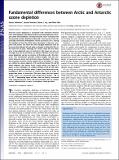Fundamental differences between Arctic and Antarctic ozone depletion
Author(s)
Solomon, Susan; Min, Flora; Haskins, Jessica D.; Ivy, Diane J
DownloadSolomon_Fundamental differences.pdf (1.495Mb)
PUBLISHER_POLICY
Publisher Policy
Article is made available in accordance with the publisher's policy and may be subject to US copyright law. Please refer to the publisher's site for terms of use.
Terms of use
Metadata
Show full item recordAbstract
Antarctic ozone depletion is associated with enhanced chlorine from anthropogenic chlorofluorocarbons and heterogeneous chemistry under cold conditions. The deep Antarctic “hole” contrasts with the generally weaker depletions observed in the warmer Arctic. An unusually cold Arctic stratospheric season occurred in 2011, raising the question of how the Arctic ozone chemistry in that year compares with others. We show that the averaged depletions near 20 km across the cold part of each pole are deeper in Antarctica than in the Arctic for all years, although 2011 Arctic values do rival those seen in less-depleted years in Antarctica. We focus not only on averages but also on extremes, to address whether or not Arctic ozone depletion can be as extreme as that observed in the Antarctic. This information provides unique insights into the contrasts between Arctic and Antarctic ozone chemistry. We show that extreme Antarctic ozone minima fall to or below 0.1 parts per million by volume (ppmv) at 18 and 20 km (about 70 and 50 mbar) whereas the lowest Arctic ozone values are about 0.5 ppmv at these altitudes. At a higher altitude of 24 km (30-mbar level), no Arctic data below about 2 ppmv have been observed, including in 2011, in contrast to values more than an order of magnitude lower in Antarctica. The data show that the lowest ozone values are associated with temperatures below −80 °C to −85 °C depending upon altitude, and are closely associated with reduced gaseous nitric acid concentrations due to uptake and/or sedimentation in polar stratospheric cloud particles.
Date issued
2014-04Department
Massachusetts Institute of Technology. Department of Earth, Atmospheric, and Planetary SciencesJournal
Proceedings of the National Academy of Sciences
Publisher
National Academy of Sciences (U.S.)
Citation
Solomon, S., J. Haskins, D. J. Ivy, and F. Min. “Fundamental Differences Between Arctic and Antarctic Ozone Depletion.” Proceedings of the National Academy of Sciences 111, no. 17 (April 14, 2014): 6220–6225.
Version: Final published version
ISSN
0027-8424
1091-6490